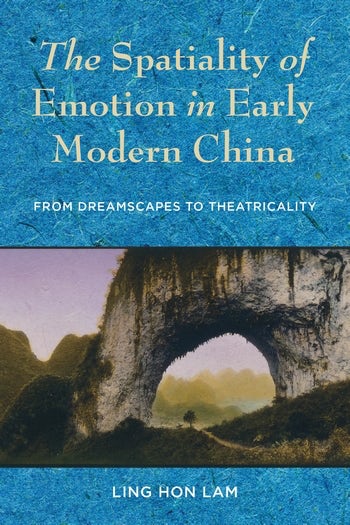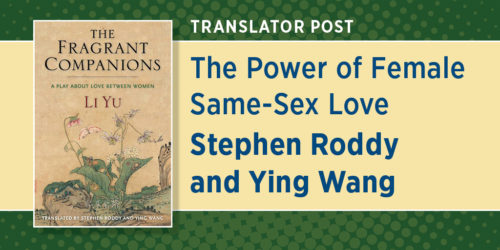Emotion Takes Place

“Ling Hon Lam’s book is a major breakthrough in early modern Chinese literary and theater studies. Lam challenges conventional wisdom that sees emotion as an expression of inner faculties, and seeks to reframe emotion as affective performativity, theatrical manifestation, and above all, spatial construct.”
~ David Der-wei Wang, Harvard University
This week, we are featuring works on Chinese history, religion, and literature. We’re wrapping up the work week with a guest post from Ling Hon Lam, author of The Spatiality of Emotion in Early Modern China: From Dreamscapes to Theatricality—a deeply original account of the history of emotions in Chinese literature centered on the idea of emotion as space. Tracing how the emotion-realm underwent significant transformations from the dreamscape to theatricalityin sixteenth- to eighteenth-century China, this book is a major rethinking of key terms in Chinese culture.
Enter our book giveaway by Friday at 1 PM for a chance to win a free copy!
• • • • • •
“I compel my mind to make one further effort, to follow and recapture once again the fleeting sensation… And then for the second time I clear an empty space in front of [my mind]. I place in position before my mind’s eye the still recent taste of that first mouthful, and I feel something start within me, something that has been embedded like an anchor at a great depth.”
~ Marcel Proust, Swann’s Way
“Clearly the bright sun is up in the bright blue sky,/ Momentarily making me unable to grasp things to the front of the soul’s dream.”
~Tang Xianzu, The Peony Pavilion
Both Proust’s celebrated “madeleine” moment and the late sixteenth-century Chinese playwright Tang Xianzu’s dream scenes have been savored for their profound exploration of an individual’s interior. But before slipping too quickly into the “great depth” or “the soul’s dream,” let us attend to the space cleared in front of the mind and the dream. Isn’t it this space, not the interior, where the otherwise fleeting sensation resides?
My book on early modern Chinese literary and theatrical culture dwells on this oft-overlooked “spatiality of emotion,” by which I mean emotion is not an inner, mental state but a spatial structure. Related phenomena are everywhere in daily life: the ominous atmosphere one immediately senses when walking into a meeting room, or the sunny sky to which we refer when greeting each other in the morning. But we constantly explain away these quotient experiences by presuming the interior locus of emotion, which supposedly interacts with an outside world from which it is always already separate in the first place: so, as it goes, my mental state is lit up by the good weather, or the gloominess in me imbues the color of the surrounding, or it is through pheromones in the air (or alternatively, the mirror neurons inside my body) that I perceive others’ mood.
“Emotion is not caused by, projected to, or associated with the external world; rather, emotion per se is already a realm, a situation, an embedding sphere we find ourselves in. ”
All these explanations feel superfluous and convoluted once we come to recognize that we are in the mood, not the other way around. As if to drive home this point, the Chinese word for emotion, qing, is also the component for a host of phrases (qingxing, qingshi, qingkuang) that simply mean “situation.” To name the subject matter of this study, I radicalize the traditional aesthetic term qingjing, here understood not as the conjunction between “emotion” and “landscape” (which just ironically betrays their presumed disjunction), but as an “emotion-realm.” Emotion is not caused by, projected to, or associated with the external world; rather, emotion per se is already a realm, a situation, an embedding sphere we find ourselves in. By “emotion-realm,” I spell out no more than what emotion is.
While emotion-realms seem ubiquitous, their structures are historically specific; hence the various regimes of emotion-realms predicated on distinct spatial organizations. My book focuses on the transition between the middle-period and the early modern regimes of emotion-realms in sixteenth to eighteenth-century China—namely, the dreamscape and theatricality. In dreamscapes, emotions were territorialized as an infinite layering of real and unreal through which one was incessantly delivered from one ephemeral mood to another. Theatricality arose when the dreamer stopped falling through oneiric layers and took a pause in front of the dream, whereupon she turns into a spectator of others’ and her own emotion, trying to empathetically identify with it at an indelible distance. As a defining symptom of theatricality, the discourse of empathy, or to borrow a sixteenth-century Chinese idiom, sheshen chudi (putting oneself in the other’s case), mushroomed across then-contemporary drama theory, fiction commentary, poetics, politics, interpretations of history, and classic exegesis. If the German term Einfühlung was interpreted in terms of sheshen chudi when imported into early twentieth-century China, that means at some point preceding that, both China and the West had already converged in a global era of theatricality, so that Tang Xianzu and Proust, despite all their historical differences, dwell on similar emotion-realms. What is more intriguing is the diverse trajectories China and the West had taken in their respective genealogies of emotion-realms toward this point of convergence and how these trajectories shaped the ensuing experiences with theatricality differently. As illustrated at the end of my book, however, this global history depicts less a teleological triumph of theatricality than a nonlinear unfolding marked by repetition and misrecognition between theatricality and its predecessors in both traditions.
“Ultimately, any attempts to explain how theatricality emerged must tackle first its complex relationship to its historical other, namely, the dreamscape.”
This genealogical study of emotion-realms not only demonstrates a new way to historicize emotion without essentializing interiority or even the social process of interiorization; more important, it lays the foundation for revisionist histories of moral philosophy, theater, and knowledge production, thus giving a thorough reflection upon how we pray and play, feel and know. Whereas conventional intellectual history presumes inherent emotions and desires as the essential object in Chinese philosophy and religion, whether to be regulated, suppressed, or liberated, my critique of interiority calls for a genealogy of morals, which investigates how such moral issues are merely secondary reactions to the ontological ambiguities arising from the spatial organization of each particular regime of emotion-realms. By the same token, whereas spectatorship is widely presumed as the universal or even central category to traditional Chinese theater, my historicization of the “spectator” as a construct in the era of theatricality necessitates a genealogy of “playgrounds” that has to trace back to a theater without spectatorship on the one hand—i.e., a theater whose spatial logics of performance draws on the dreamscape rather than theatricality—and, on the other hand, to rectify our understanding of theatricality not as a transhistorical essence of theater but as a specific mode of spatiality underlying the early modern transmedia culture. In other words, theatricality takes place in the interface between page and stage, ushering in a proto-screen culture epitomized by “the front of the soul-dream.”
Ultimately, any attempts to explain how theatricality emerged must tackle first its complex relationship to its historical other, namely, the dreamscape. But as descendants of theatricality, one may ask, how can we expect to know a different regime that we tend to have forgotten? This epistemological question now becomes superfluous, though, simply because the very notion of emotion-realms invalidates the assumption underlying epistemology that the outside world is separate from the interior subject and is only knowable to her through dubious representation. The question should not be dismissed but qualified as a historically specific one made possible only within the regime of theatricality, which easily gives the impression that I can’t feel what others feel except through empathetic imagination. A mass shooter featured almost daily in news thus shoots the question back in our faces, at once rhetorical and real—“Did he ever feel others’ pain!?”—exactly the same question late nineteenth-century Westerner observers asked of the allegedly unfeeling Chinese, a self-contradictory expression of both moral condemnation (of course humans except for this monster can feel each other’s pain) and desperate curiosity (what he feels or “unfeels” lies hopelessly beyond our empathetic understanding). Similarly, in showing how the epistemological question is superfluous yet historically poignant, the genealogy of emotion-realms entails a self-reflexive critique of its own possibility by thinking through knowledge in genealogical terms. The whole book of mine can be taken as a long answer to this methodological perplexity of the human sciences as well as to the bewildering predicament of contemporary society, which my most attentive readers would hopefully find rewarding.
Read more about the “spatiality of emotion” in this excerpt from the book’s prologue.





